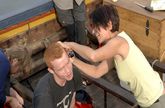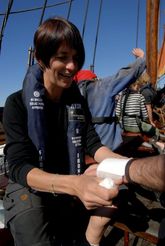Nurse

A nurse is extremely important part of the crew on board the Sea stallion. She is not curring war wounds, but sea sickness, blisters and other diseases and injuries.
The task and responsibilities of the nurse
Prior to a voyage the nurse participates in formulating a plan for how the injured are to be treated in the event of an emergency or if the ship should sink.
Further to this the nurse and the skipper have produced bills of health to be completed by all members of the crew. These contain the names, addresses and telephone numbers of close family, information about any illnesses that a crewmember has or has had, as well as about any medication being taken. These bills help the nurse in the prevention of illness and in treating the crew during the voyage.
In case of illness, wounds or injuries during the voyage it is the nurse's task to treat and take care of the patient. The nurse has a chest with medicine and another chest with equipment for treating more serious injuries. In the latter there are dressing materials, medicine, resuscitation equipment and splints for broken legs or arms or even the neck and back.
The nurse forms part of the regular watch system, and participates in rowing and sailing the ship. In case of serious illness or an accident on board the nurse is excused from other duties in order to give first aid. Furthermore, all members of the crew have been through a first aid course and been taught cardiac massage and how to administer artificial respiration so they are able to assist. It is also possible to establish sick berths on board where the patients can rest and sleep. Doctors on land, including Radio Medical, which is a 24-hour service, can be contacted via the ship's radio.
Diseases and injuries on board
Seasickness, diarrhoea, nettle rash, concussion, hypothermia, burns, blisters and minor cuts are some of the illnesses and injuries occurring on the Sea Stallion's summer voyages. All of them occurr due to the weather conditions and are a result of the crew being modern people working under conditions to which they are unaccustomed.
- Seasickness is hard to avoid, and many were affected by nausea and tiredness. The illness generates sadness and indifference. There are even stories of sailors throwing themselves over board in order to rid themselves of the pain.
- Minor cuts and blisters, caused by the hard physical work of handling the sail, the heavy ropes and the rowing, are also a natural part of life on board.
- Heatstroke. The weather was extremely fine and sunny during the voyage to Norway in 2006, and this caused a few cases of heatstroke . The burning sun and the high temperature, combined with hard, physical activity, caused major fluid loss. Many of the crew had possibly drunk too little water and were not covered up properly.
- Nettle rash is also a result of the hard physical work, and the limited opportunities to wash and rinse away sweat led to rashes and itching.
- Hypothemia was a serious risk on the vouage to Dublin. The rain and the cold night at open sea made a lot of people really cold. When being that cold people loose the capability to move, think and talk.
Diarrhoea occurred during the voyage to Norway, but worse cases were avoided due to strict hygiene rules concerning cooking, serving of food and visits to the toilet. Surgical spirit and disinfectant cloths constituted part of the cleaning regime for the galley and the ship's two toilets, which were to be wiped over after each visit. Further to this, there were rules concerning thorough washing of hands prior to cooking and after all visits to the toilet – also in the event of urinating over the ship's side. Furthermore, several crewmembers had taken along wet wipes for daily washing of their face, hands etc. When the crewmembers went bathing, many took their clothes with them and washed them at the same time.
Fact: During every long expedition the nurse will keep diaries and write down which illnesses, injuries and minor cuts affect the crew and how these are treated, as well as experience with the sanitary conditions. This information is to be used in connection with future voyages and to learn more of life on board a Viking ship.
Whether the Vikings suffered from the same illnesses 1000 years ago is almost impossible to discover. Life and, especially, conditions on board ship, then and now, are so different that it is difficult to tell. Presumably wounds and injuries from battles were treated on board the warships, and blisters and seasickness were just a natural part of the voyage. Minor wounds and injuries were, however, much more serious in the Viking Age. There are archaeological finds of instruments for the cleaning and healing of wounds showing that the Vikings knew of the danger of infections. However, it is probable that infections in minor wounds would, throughout history, have led to blood poisoning, amputation and, in the worst cases, deaths. Today, infections are treated with antibiotics.
By: Louise Kæmpe Henriksen
